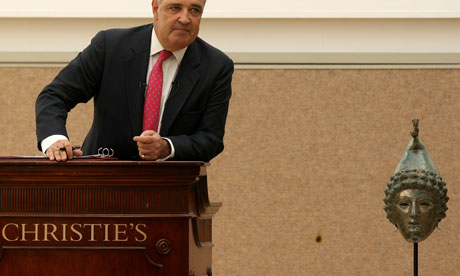In just three minutes at a Christie's auction, the most hauntingly beautiful face to emerge from the British soil in more than a century slid out of the grasp of the museum desperate to acquire it when the Roman helmet was sold to an anonymous telephone bidder for £2m [see footnote] – dramatically higher than the highest pre-sale estimate of £300,000.
The man who found it last May, using a metal detector on farmland on the outskirts of the Cumbrian hamlet of Crosby Garrett, a currently unemployed graduate in his early 20s from the north-east, will share the price with the landowner, but is now a millionaire.
Tullie House museum in Carlisle managed to stay in the bidding up to £1.7m, a staggering sum for a small museum raised in gifts and grant promises through frantic fundraising in the last month. Three more bids of £100,000 each lost it the treasure.
"I'm still shaking," Andrew Mackay, senior curator at the museum, said moments later. "Cumbria has had a few bad knocks recently, and this fundraising campaign was a good news story for the area, so this is a real blow. People will be terribly disappointed – we had thousands of pounds coming in every day, and children literally emptying their piggy banks.
"We are now very, very anxious to talk to the buyer to see where we go next."
The stunning Roman cavalry helmet, dating from the late first or early second century AD, a piece of public swagger for parades and festivals never meant to be worn in combat, is only the third ever found complete in Britain, the first since 1905, and by far the most beautiful.
It has transfixed thousands of visitors in the past week, when it went on display for the first time at Christie's in South Kensington. People have stood gazing into the dreamy youthful face, the mouth slightly parted, the eyes with their delicate cut-out pupils. Christie's sources report that, uniquely, many viewers had asked where they could donate to the campaign to keep it in a British museum.
Christie's could not reveal whether the buyer is British or overseas – a Californian phone bidder, presumed to be the Getty museum, dropped out at £800,000 – but the museum's best hope is that it is either a UK buyer willing to loan, or if it has been bought overseas that the government will impose an export bar to allow time to raise the money to match the sale price.
Only a handful of helmets such quality have been found anywhere across the former Roman empire, and potential buyers from all over the world registered interest.
The finder and his father had searched the same fields for years, with the permission of the landowner, and never found anything more exciting than a few coins and some bits of broken horse harness: he continued going there, he has explained, because he liked the views.
When he found the helmet face down in the clay, the silvered face intact but the Phrygian cap and its jaunty little griffin topknot crushed into many pieces, he first thought it was a Victorian ornament.
His good fortune has exposed a gaping hole in Britain's protection for archaeological heritage finds, and is bound to lead to calls for reform of the Treasure Act.
If the helmet had fallen within the legal definition of treasure, the finder and landowner would have been awarded compensation at the market price, and it would probably already be on display in the Tullie House galleries.
However, only objects with a large composition of gold or silver, such as the spectacular Staffordshire hoard of Anglo Saxon gold which was acquired last year by a coalition of local museums, or prehistoric hoards of bronze such as the find earlier this year of a vast clay pot in Frome holding 52,000 mainly low-value coins, fall within the law. A single bronze object, however astonishing, is not legally treasure.
The finder was not even legally obliged to report the helmet, although he chose to do so under the voluntary portable antiquities scheme (Pas) for reporting archaeological finds, and he was fully entitled to turn down the suggestion of a negotiated sale to the museum, and instead send it straight to auction.
"It's so frigging annoying," said Sally Worrell, the Pas finds officer who first saw the mask. "I'm gutted to be honest – it's so frustrating to have worked so long on this and then not see it go to the museum."
Roger Bland, head of the Pas, based at the British Museum, whose Roman experts have fully backed Tullie House's attempt to acquire it, agreed. "It does expose a real gap in the treasure law – a review was promised three years ago, and if it had been carried out, this outcome could have been avoided."
The report of the find does mean the find spot is recorded and full archaeological excavation to uncover the riddle of how such a stunning object ended up in a nondescript field miles from the nearest Roman site may still follow.
• This footnote was added on 8 October 2010. £2m is the saleroom 'hammer price', ie the final bid that secures the sale. The overall price will include the buyer's premium of around 15% to give a total figure of approximately £2.3m.










